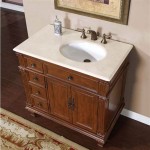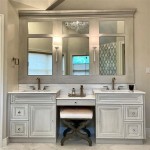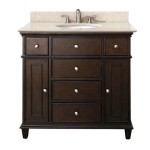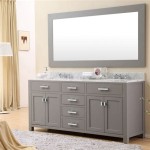Laminate Vanity Top Without Sink: A Comprehensive Guide
The bathroom vanity is a crucial element of any bathroom design, offering both functionality and aesthetic appeal. The vanity top, in particular, plays a significant role. While numerous materials are available for vanity tops, laminate represents a cost-effective and versatile option, especially when purchased without a pre-installed sink. This article provides a thorough examination of laminate vanity tops without sinks, exploring their benefits, considerations, installation, maintenance, and design possibilities.
Laminate, as a material, is a composite made by pressing thin layers of paper and resin together under high heat and pressure. This process creates a durable and water-resistant surface suitable for bathroom environments. The top layer, often printed with a decorative pattern or color, is protected by a clear wear layer, enhancing the longevity of the surface. When purchasing a laminate vanity top without a sink, individuals gain greater flexibility in selecting a sink that perfectly matches their style and needs.
Understanding the Advantages of Laminate Vanity Tops
Laminate vanity tops offer several distinct advantages, making them a popular choice for bathroom renovations and new construction projects. These benefits include affordability, design flexibility, ease of maintenance, and water resistance.
Affordability: Laminate is significantly less expensive than natural stone options such as granite or marble. This makes it an attractive choice for budget-conscious homeowners or those undertaking large-scale renovations where material costs can quickly escalate. The initial cost savings can be substantial, allowing funds to be allocated to other aspects of the bathroom design or to higher-end fixtures and fittings.
Design Flexibility: Laminate is available in a vast array of colors, patterns, and textures. It can mimic the look of natural stone, wood, or even more contemporary designs. This extensive selection allows homeowners to achieve their desired aesthetic without the expense associated with authentic materials. Furthermore, purchasing a vanity top without a pre-installed sink provides the freedom to choose a sink style (undermount, vessel, drop-in) that complements the overall design vision.
Ease of Maintenance: Laminate is relatively easy to clean and maintain. Its smooth, non-porous surface resists stains and spills, making it ideal for a bathroom environment where moisture and cleaning products are frequently present. Routine cleaning typically involves wiping the surface with a damp cloth and mild detergent. Unlike some natural stone options, laminate does not require sealing or specialized cleaning products.
Water Resistance: While laminate is water-resistant, it's crucial to understand its limitations. The surface itself is resistant to water damage, but the edges and seams are vulnerable to moisture penetration if not properly sealed. Careful attention to sealing these areas during installation is essential to prevent swelling, peeling, or other forms of water damage. Choosing a high-quality laminate with a durable wear layer can further enhance its resistance to moisture.
The versatility and cost-effectiveness of laminate makes it a practical option for a wide spectrum of bathroom designs. The ability to choose a sink separately greatly increases the designer's control over the finished look.
Key Considerations When Choosing a Laminate Vanity Top
Selecting the right laminate vanity top without a sink requires careful consideration of several factors. These include the quality of the laminate, the dimensions and shape of the vanity, the type of sink to be installed, and the edge profile.
Laminate Quality: The quality of the laminate directly impacts its durability and longevity. Look for thicker laminates with a durable wear layer to resist scratches, stains, and fading. Check the manufacturer's specifications for the laminate's resistance to heat, moisture, and chemicals. Opting for a reputable brand known for producing high-quality laminates can ensure a longer lifespan and better performance.
Dimensions and Shape: Accurately measure the existing vanity or the space where the new vanity will be installed. Consider the desired overhang of the vanity top beyond the cabinet base. Laminate vanity tops are available in standard sizes and shapes, but custom sizes may be necessary for unique bathroom layouts. The shape of the vanity top should complement the overall design of the bathroom and the style of the vanity cabinet.
Sink Type: The choice of sink is a critical factor in selecting a laminate vanity top without a sink. Different sink types require different cutouts and mounting methods. Undermount sinks, for example, require a precise cutout and are mounted from below the vanity top. Vessel sinks sit on top of the vanity top and may require only a small hole for the drain. Drop-in sinks, also known as self-rimming sinks, are installed from above the vanity top and have a visible rim that rests on the surface. Ensure that the chosen sink is compatible with the laminate vanity top and that the necessary cutouts are precisely executed.
Edge Profile: The edge profile of the laminate vanity top contributes significantly to its overall appearance. Common edge profiles include straight edges, beveled edges, rounded edges, and ogee edges. The choice of edge profile should complement the style of the bathroom and the vanity cabinet. Consider the practicality of the edge profile as well. Rounded edges, for example, are less likely to chip or crack than sharp edges.
Taking these considerations into account during the selection process contributes to a successful installation and ensures the laminate vanity top meets the aesthetic and functional requirements of the space.
Installation and Maintenance of Laminate Vanity Tops
Proper installation and regular maintenance are essential for maximizing the lifespan and performance of a laminate vanity top. While professional installation is recommended, experienced DIY enthusiasts can successfully install a laminate vanity top with careful planning and execution. Maintaining the laminate surface involves routine cleaning and preventative measures to protect it from damage.
Installation Process: The installation process typically involves securing the laminate vanity top to the vanity cabinet using construction adhesive and screws. Before installation, ensure that the vanity cabinet is level and stable. Apply a bead of construction adhesive to the top edges of the cabinet frame. Carefully position the laminate vanity top onto the cabinet, ensuring that it is properly aligned. Secure the vanity top to the cabinet by driving screws through the cabinet frame and into the underside of the laminate top. For undermount sinks, the cutout must be precise, and the sink must be securely attached to the underside of the vanity top using appropriate mounting hardware and sealant. After installation, seal the edges and seams of the laminate vanity top with a waterproof sealant to prevent water penetration.
Cleaning and Maintenance: Regular cleaning is essential for maintaining the appearance and hygiene of a laminate vanity top. Wipe the surface with a damp cloth and mild detergent to remove dirt, spills, and stains. Avoid using abrasive cleaners, scouring pads, or harsh chemicals, as these can damage the laminate surface. For stubborn stains, try a paste of baking soda and water or a specialized laminate cleaner. Always rinse the surface thoroughly with clean water and dry it with a soft cloth. Regularly inspect the edges and seams of the vanity top for signs of damage or water penetration. Reapply sealant as needed to maintain a waterproof barrier.
Preventative Measures: Taking preventative measures can help extend the life of a laminate vanity top. Use coasters or mats under hot items to prevent heat damage. Avoid placing heavy objects directly on the surface, as this can cause scratches or dents. Wipe up spills immediately to prevent staining. Consider using a protective countertop spray or polish to enhance the laminate's resistance to scratches and stains.
By following these installation guidelines and maintenance tips, individuals can ensure their laminate vanity top remains attractive and functional for many years. This approach maximizes the return on investment and avoids the need for costly repairs or replacements.
The ability to install a sink separately from the vanity top also allows for a more customized installation process. For example, plumbing can be adjusted more easily without the constraints of a pre-installed sink.
In conclusion, laminate vanity tops without sinks present a compelling blend of affordability, versatility, and ease of maintenance. By carefully considering the various factors discussed and adhering to proper installation and maintenance practices, individuals can select and enjoy a laminate vanity top that enhances both the functionality and aesthetics of their bathroom.

Paint Bathroom Vanity Countertop Sink So Easy A Piece Of Rainbow
:strip_icc()/102130266-3174ac7d31314c7abfc80a1b65a11dd6.jpg?strip=all)
40 Luxurious Bathroom Countertop Ideas For All Budgets

Removing The Side Splash Backsplash From Our Bathroom Sink Young House Love

Hpl Postformed Laminated Vanity Top Units Washrooms

How To Diy Remove Replace A Bathroom Vanity Countertop What Not Do Yep I Broke It Youtube

Prefabricated Laminate Natural Yellow Granite Countertops Vanity Top For Bathroom

25 In W X 19 D Granite White Rectangular Single Sink Vanity Top Beige

Luxury Bathroom Vanity Tops Native Trails

Best Countertop Materials For The Bathroom Lx Hausys

Paint Bathroom Vanity Countertop Sink So Easy A Piece Of Rainbow







